Friday Essay: a black marlin at Port Kembla and an 8,000-year-old midden – nature in the 21st century
- Written by Michael Adams, Associate Professor of Human Geography, University of Wollongong
The shaky video shows the crescent tail cutting through water as the black marlin swims through the creek, hunting bream and tailor.
As the phone camera pans around, the built structures of the Port Kembla steelworks in south eastern Australia come into view, heavy trucks rolling over a concrete bridge, smokestacks and factories crowding the landscape. The roofs, pipes and conveyors are rust-brown, soot and grime coat the surfaces, sulphuric smells drift across the space.
We know this because a steelworker happened that day to see this marlin in the steelworks and filmed it. I found his footage recently when searching Google for information on local creeks. It is highly likely that this sighting was not a one-off event, that large predatory fish like the marlin now periodically hunt in the steelworks unseen by human eyes, or if seen, unreported. The processes of rewilding leak across time and across tenures, the push of natural forces pulsing more strongly as the industrial force of the steelworks declines.
The black marlin is an apex predator of oceanic environments, a wide-ranging swimmer that can grow to 800 kilograms. Marlins have a long, pointed, spear-like bill and a rigid dorsal fin that makes a crest along their back. Regarded as the premier game fish amongst anglers, they epitomise the oceanic wild: fast, powerful and beautiful.
A close relative of the black marlin is the huge iconic fish at the centre of Hemingway’s The Old Man and the Sea. And the black marlin, like all animals, is part of a cosmos beyond and including humans, as American nature writer Henry Beston has argued:
In a world older and more complete than ours, they move finished and complete, gifted with the extension of senses we have lost or never attained, living by voices we shall never hear.
A symbol of new and ancient ways
The most polluted creek in the Illawarra region of New South Wales, Allens Creek flows through the steelworks, its banks lined with concrete and weeds, its channel littered with plastic, broken glass and rusting steel. Its waters and banks are a complex amalgam of industry, abandonment, toxicity, flourishing and decline.
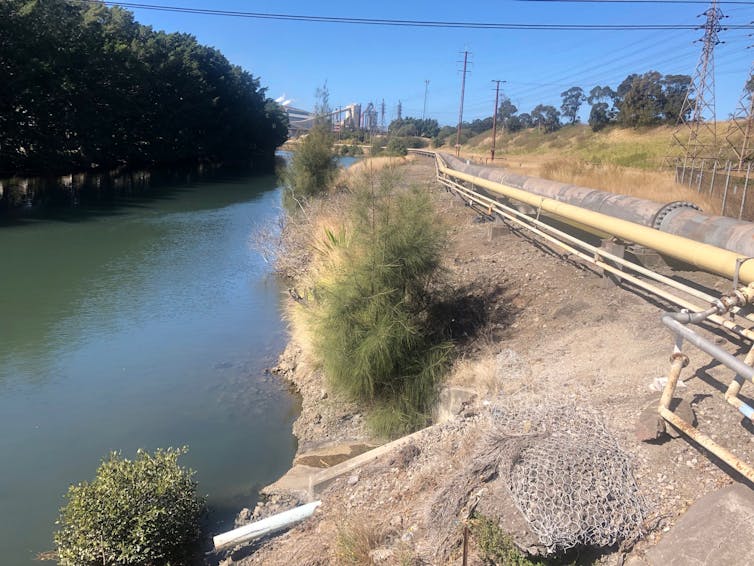 Allens Creek: the most polluted creek in the Illawarra region.
Michael Adams
Allens Creek: the most polluted creek in the Illawarra region.
Michael Adams
The black marlin was not lost, as some fishers mused. It was in the steelworks with intent and agency, likely following a faint heat trace leaked from the warmed waste waters that support unique marine ecosystems in industrial estuaries.
These margins and ignored edges of industrial Illawarra — marine, freshwater and terrestrial — are home or refuge to a range of human and non-human presences, providing unique opportunities unavailable in the planned and managed land and seascapes surrounding them.
Five kilometres from and in sight of the towering flare stacks of the steelworks, a coastal rockshelf extends north from a local beach. This forgotten corner hosts an Aboriginal shell midden maybe 8,000 years old. Patrick Nunn’s remarkable book The Edge of Memory documents how, at the end of the last Ice Age in south east Australia, sea levels were rising rapidly, moving as much as 20 metres horizontally every year.
Read more: Ancient Aboriginal stories preserve history of a rise in sea level
Yuin saltwater Aboriginal people observed and responded to these changes, watching their campsites and hunting grounds disappear underwater, seeing their fishing areas deepen and change. The descendants of those people continue to harvest from those waters today, still here because of their skill in responding to immense environmental and social change.
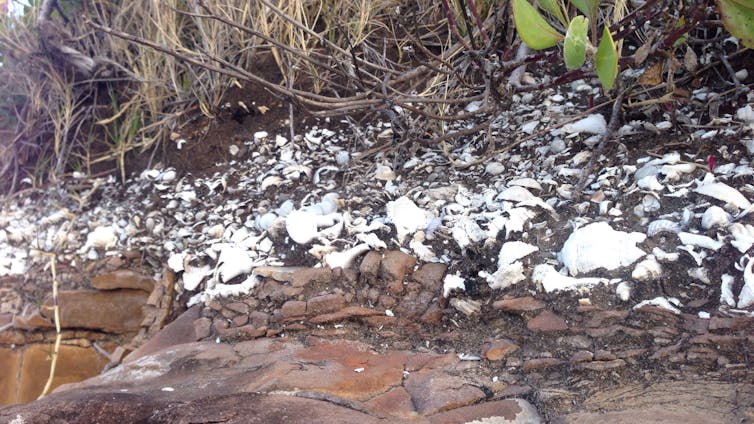 Shell material in the midden near the steelworks.
Michael Adams
Shell material in the midden near the steelworks.
Michael Adams
The presence and agency of the black marlin in the middle of the steelworks brings into focus debates about the place of nature in the 21st century. The giant ocean fish swims into the heart of industrial Port Kembla because the “dirty ecologies” of this human-transformed environment provide resources and shelter.
What if we take its presence, a few kilometres from the ancient, living midden, as a symbol of both new and ancient ways to learn? What does the water and its denizens have to teach us? How do we learn from these places on the margins?
Dirtying ecology
In 2012, the extraordinary film Beasts of the Southern Wild was released. Nominated for four Academy Awards, it is simultaneously speculative and deeply realistic.
The film’s imagined Louisiana community of the Bathtub, lost in the interstices and floodzones of the modern American juggernaut, reflecting class and racial neglect, endures a Katrina-esque storm.
But the Bathtub, like Allens Creek and Port Kembla, is not just an industrial wasteland: it is also full of life and energy. Both humans and non-humans living in these environments thrive or struggle with repurposed elements from previous and neighbouring ecologies. The toxic dirt and debris of the steelworks waterway are the hidden byproducts of the glistening steel towers in modern cities; the marginalised workers fishing in these waters are increasingly discarded by the processes of capital and automation.
Commenting on Beasts of the Southern Wild, the late feminist literary scholar Patricia Yaeger argued:
The film’s rags and wastelands — its killing fields — become powerful emblems of the Southland’s (and our nation’s) commitment to toxic inequality … The citizens of the Bathtub practice a dirty ecology, making do with what they can salvage from other waste-making classes.
The redundant maintenance workers of Port Kembla — which in 30 years has lost 17,000 jobs in the steelworks — have similarly taken their skills into an invisible underground economy of community repair and maintenance. Geographer Chantel Carr says, “They look at the world with the viewpoint that everything can be used for something else”. Her work and that of others suggest we need to “invert vulnerability”, to find there instead capacity, endurance and resolve.
In both popular and scientific discourse there is an increasingly insistent environmental story of damage, extinction and decline. Simultaneously, environmentalists and conservation scientists are arguing for increased use of the standard Western tools of conservation: protected areas or other conservation zones, threatened species recovery plans, and feral species management.
Increasingly, more and more species have less habitat available to them, and more native species approach extinction. At the same time, newly moved species are flourishing in environments all over the world.
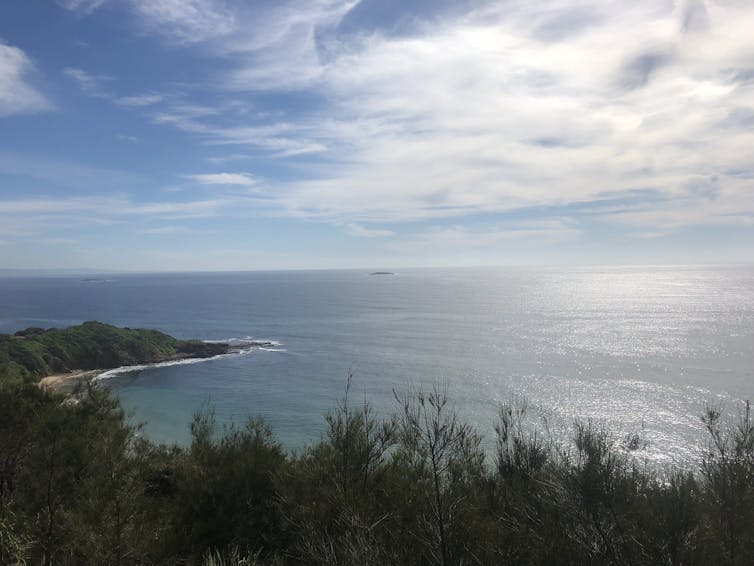 The rockshelf near the midden.
Michael Adams.
The rockshelf near the midden.
Michael Adams.
Western (modern) conservation attempts to reverse both processes: we kill more feral animals and we attempt to keep alive more declining species by declaring more protected areas and “recovering” those species. So there are two great trajectories of living and dying, and modern humans attempt to reverse them both, while actually also being the agents driving those trajectories.
Political ecologist Audra Mitchell describes this as a “managing life and death processes” that leaves the species which survive living “controlled existences in parks, reservations, zoos or petri dishes.”
Yaeger, arguing the urgent need for a new vision of our relationship with the natural world, asserts “we must dirty ecology, the science of whole environments, with myths, fictions, half-truths, dirty imagery”. Bringing together the mesh of what these differing ideas offer might help us.
Unguarded, unmanaged spaces
I want to argue then that all environments are still whole environments, that the whole is constantly reassembled, reorganised, from the available constituent parts and processes. And that the planet has been through these processes before, in fact, relatively recently.
In the 1960s, Buckminster Fuller argued “nature never ‘fails’.” But more relevantly for us in Australia and more broadly, as Indigenous Australian Waanyi writer Alexis Wright has written:
I am talking about time immemorial experience – how to grow roots like that. Not like scrap of paper made yesterday – a second ago, flimsy, impermanence, that type of thing saying you got the title over blackfella country, you are on top. That’s nothing. You are not owner. Scrap of paper only painful in the heart, only cover the surface with poison. It can’t get inside proper deep law in my head …
The spaces of Allens Creek — marine, aquatic and terrestrial — are constantly rewilding themselves. Country reasserts itself everywhere. These are the unguarded, unmanaged spaces where lives can flourish and decline unobserved by the auditing eyes of power. Where futures can be surprising, paradoxical and spontaneous. The black marlin can travel from the open ocean into the steelworks to find new resources for its life. The living midden archives millenia of data about climate change, extinctions, the presence of new species, the sustainability of ancient harvests, and human and non-human responses.
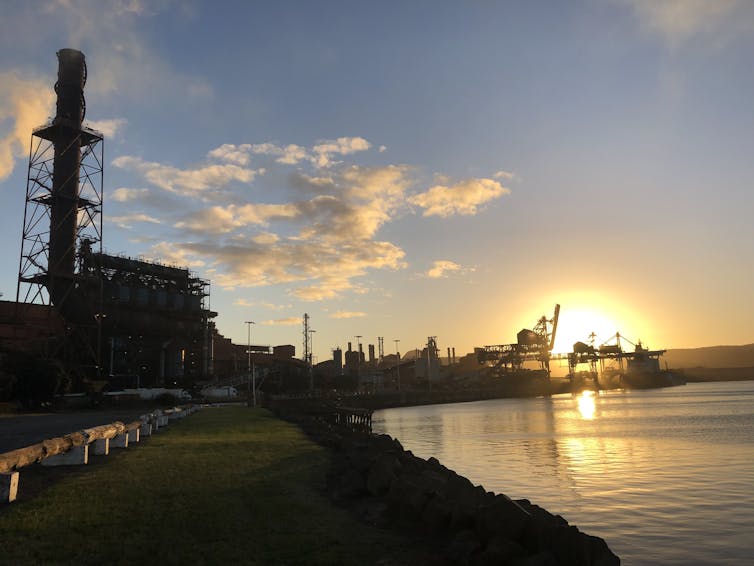 Port Kembla steelworks, outer harbour.
Michael Adams
Port Kembla steelworks, outer harbour.
Michael Adams
One of the local fishers commenting on the marlin video said, “yeah, but I wouldn’t want to eat it.” He refers to presumed levels of toxicity stored in the fish’s body from feeding in highly polluted environments.
Bioaccumulation of toxins is a well known issue with large predatory fish like marlin. But because industrially-produced heavy metals have been present in mining and manufacturing regions now for centuries, some species are evolving in response to this presence. A recent study in the Australian mining town of Broken Hill showed that an isolated population of introduced house sparrows there had evolved to avoid lead poisoning – they had developed a genetic adaptation to avoid the uptake of lead in their bodies.
While we don’t know about this in marine species, recent studies indicate surprising outcomes. Port Kembla in the past had internationally high levels of metal contamination, leading to scientific prediction that such places would be low in biodiversity and have simplified and impoverished ecosystems.
However a recent detailed survey of south east Australian estuaries, including Port Kembla, by a team of marine researchers concluded, “on the contrary, communities in modified estuaries had greater species cover and were comparable in diversity to those in unmodified estuaries”.
Still, like the midden, Allens Creek is also an archive of industrial debris. Heavy metals are often stored in bottom sediment, retaining their toxicity, unproblematic until they are disturbed.
Accepting an open future
Thinking about the effects of pollutants on our bodies and the bodies of those we eat can remind us of our animality. Our shared material bodies — humans, the black marlin, the ocean water itself — are composed of the same elements: each is a rearrangement of the other, and each will be rearranged again as they die and return to the matrix from which the next lives will grow.
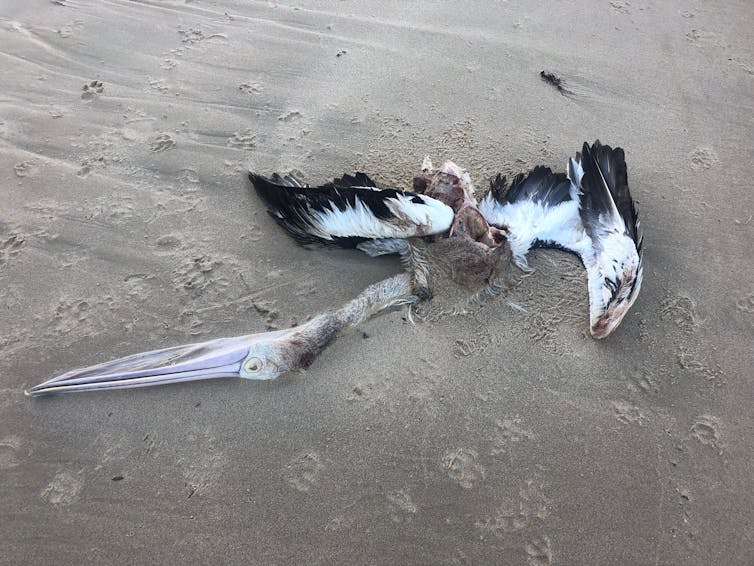 A dead pelican on the beach near the Aboriginal midden.
Michael Adams
A dead pelican on the beach near the Aboriginal midden.
Michael Adams
The evolutionary processes that created the minds and bodies of Yuin Aboriginal people, the British colonisers, and the black marlin, are the same. Australian environmental philosopher Val Plumwood’s famous crocodile attack story, Being Prey, reminds us we can reenter the food chain in a different place. We can be both predators and prey: not just eaters of species we judge appropriate and killers of species we judge not appropriate.
Part of this opportunity for learning is to respect the knowledge of those vernacular in-between worlds. Another part is to trust our ancient ways of understanding that lie beneath the more recent cognitive processes and cultural conditioning.
Our Western preoccupation with planning, with certainty, is a recent and particular phenomenon. In The Great Derangement, Indian writer Amitav Ghosh argues that this is an outcome of colonialism, with the industrial and scientific revolutions paralleling the expansion of European nations, who initiated the practices of capitalist extractive practices in their colonies.
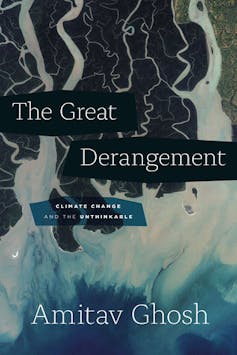 Ghosh argues for acknowledging the limits of human cognition in responding to unknown futures. Climate researcher Mike Hulme also reflects this position: “We know how the world works, but we no longer know what it means.”
But note that this is a particular “we”: Western, modern, maybe still largely white. That is me also, a beneficiary of the ongoing colonial and capitalist processes that are the cause of our planetary predicament. Which is why I think people like me need to commit to examining the insights from people, and other beings, not like me. We can take a lesson from many Indigenous cultures and understand that everything and everyone can be a teacher.
The black marlin, hatched in waters hundreds of kilometres away, could not predict the food resources in the steelworks. The saltwater people who made the midden watched the waters rise with no knowledge of if or when they would stop, just as they watched the tide of colonising invaders land inexorably on their shores.
‘Radical vulnerability’
Embracing humility, listening, slowness, might transform our practices of care, of life, through making space for others, helping others endure, moving our dominant human selves to the edges instead of the centre. Becoming less secure, more vulnerable. Finding attention, rather than fear. Geographer Natalie Osborne at Griffith University, recently tweeted:
I’m here for radical vulnerability, for attentiveness and care, slow, hard, messy, high stakes. We and our entanglements don’t always bounce back. Sometimes when we’re dropped, we break.
In Learning to Die in the Anthropocene, Iraq invasion veteran Roy Scranton argues that the challenges the Anthropocene pose are those with which philosophers have long engaged. “How do we make meaningful choices in the shadow of our inevitable end?”
He answers: “We can learn to see each day as the death of what came before, freeing ourselves to deal with what the present offers.”
In 2012, Aboriginal artist Jonathon Jones created an installation on Cockatoo Island in Sydney Harbour subtitled “oysters and teacups”.
Ghosh argues for acknowledging the limits of human cognition in responding to unknown futures. Climate researcher Mike Hulme also reflects this position: “We know how the world works, but we no longer know what it means.”
But note that this is a particular “we”: Western, modern, maybe still largely white. That is me also, a beneficiary of the ongoing colonial and capitalist processes that are the cause of our planetary predicament. Which is why I think people like me need to commit to examining the insights from people, and other beings, not like me. We can take a lesson from many Indigenous cultures and understand that everything and everyone can be a teacher.
The black marlin, hatched in waters hundreds of kilometres away, could not predict the food resources in the steelworks. The saltwater people who made the midden watched the waters rise with no knowledge of if or when they would stop, just as they watched the tide of colonising invaders land inexorably on their shores.
‘Radical vulnerability’
Embracing humility, listening, slowness, might transform our practices of care, of life, through making space for others, helping others endure, moving our dominant human selves to the edges instead of the centre. Becoming less secure, more vulnerable. Finding attention, rather than fear. Geographer Natalie Osborne at Griffith University, recently tweeted:
I’m here for radical vulnerability, for attentiveness and care, slow, hard, messy, high stakes. We and our entanglements don’t always bounce back. Sometimes when we’re dropped, we break.
In Learning to Die in the Anthropocene, Iraq invasion veteran Roy Scranton argues that the challenges the Anthropocene pose are those with which philosophers have long engaged. “How do we make meaningful choices in the shadow of our inevitable end?”
He answers: “We can learn to see each day as the death of what came before, freeing ourselves to deal with what the present offers.”
In 2012, Aboriginal artist Jonathon Jones created an installation on Cockatoo Island in Sydney Harbour subtitled “oysters and teacups”.
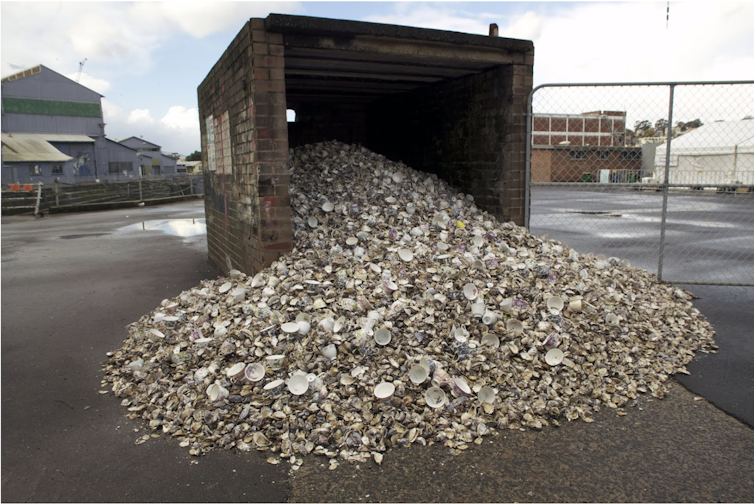 untitled (oysters and tea cups), Jonathan Jones, installation at the 2012 Biennale of Sydney.
Biennale of Sydney
The installation is an unruly cascade of hundreds of old teacups and oyster shells spilling out of an old building. The two material objects represent meetings: ceremonial and domestic gatherings of both Aboriginal people in saltwater locations and the colonisers, and the overlaps, connections and contradictions between them continuing into the present.
What Jones calls the ongoing “reign of terror” of colonisation, including its contemporary manifestations, was and is met with intelligence, strength and flexibility by those who were colonised.
Nets of connectedness
There are multiple millenia of experience with abundance and precarity on all Australian lands and waters, from both humans and non-humans. Let’s take that as background for thinking of what we might be able to learn from the black marlin and the 8,000 year-old living midden. These are not clear and concrete answers or solutions. They are indeterminate paths because we inevitably need a tentative itinerary to an obscure destination.
First, we need to recognise our inescapable precarity and indeterminacy, and begin to learn to embrace approaches that support life but recognise its ephemerality. I think we routinely forget our precarious animality, preferring instead our “resilient” humanity. We live and we die. And paradoxically, embracing this knowledge can let us visualise a future that is open and undetermined.
untitled (oysters and tea cups), Jonathan Jones, installation at the 2012 Biennale of Sydney.
Biennale of Sydney
The installation is an unruly cascade of hundreds of old teacups and oyster shells spilling out of an old building. The two material objects represent meetings: ceremonial and domestic gatherings of both Aboriginal people in saltwater locations and the colonisers, and the overlaps, connections and contradictions between them continuing into the present.
What Jones calls the ongoing “reign of terror” of colonisation, including its contemporary manifestations, was and is met with intelligence, strength and flexibility by those who were colonised.
Nets of connectedness
There are multiple millenia of experience with abundance and precarity on all Australian lands and waters, from both humans and non-humans. Let’s take that as background for thinking of what we might be able to learn from the black marlin and the 8,000 year-old living midden. These are not clear and concrete answers or solutions. They are indeterminate paths because we inevitably need a tentative itinerary to an obscure destination.
First, we need to recognise our inescapable precarity and indeterminacy, and begin to learn to embrace approaches that support life but recognise its ephemerality. I think we routinely forget our precarious animality, preferring instead our “resilient” humanity. We live and we die. And paradoxically, embracing this knowledge can let us visualise a future that is open and undetermined.
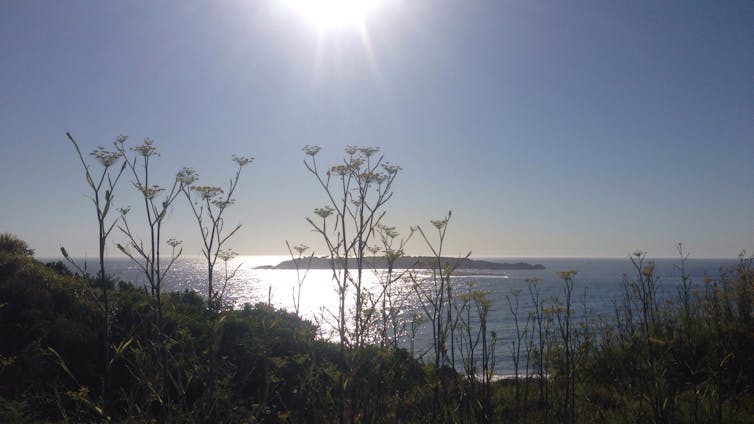 Morning near the midden.
Michael Adams
Disengaging from our obsessively consumer-driven lifestyles might help us find new pathways. Steelworkers made redundant by changing demands and technologies, like other precarious and marginalised people, have no choice but to do this.
Second, we need to invert the human command-and-control approaches to present an impending planetary unravelling. Following from Native American scholars Soren Larsen and Jay Johnson’s wonderful book Being Together in Place, humans should properly be understood as the “junior sibling” in genealogical relationship to the “first-born” status of place.
Morning near the midden.
Michael Adams
Disengaging from our obsessively consumer-driven lifestyles might help us find new pathways. Steelworkers made redundant by changing demands and technologies, like other precarious and marginalised people, have no choice but to do this.
Second, we need to invert the human command-and-control approaches to present an impending planetary unravelling. Following from Native American scholars Soren Larsen and Jay Johnson’s wonderful book Being Together in Place, humans should properly be understood as the “junior sibling” in genealogical relationship to the “first-born” status of place.
 This is true both empirically and within Indigenous ontological framing: place, oceanic and terrestrial, was first; humans entered very much later; and settler-colonists even later still.
Understanding this junior position requires humility and vulnerability. We can let place call us from that position. And consider the networks of relationships within which we live and die, both human and more-than-human.
And third, following from that, we live in a sentient world. We are surrounded by intentional ecologies. But the trajectories of our dominant belief systems, both religious and secular, mean that mostly we struggle to accept that we are not the only beings with a subject position. There are empirical ways to explore this, but I think it is important to go beyond the merely rational in our understanding. We need the facts, the empirical work, the politics – but they are not enough.
We need the creativity and mystery of the margins. We need to engage with the deep mystery and fact of our interconnectedness – what is effectively a sacred encounter.
We are biologically related to the possibly toxic body of the black marlin in Allens Creek as well as the shells and bones in the midden, and their archived record of millenia of extinction and proliferation, decline and abundance.
I think we need an embodied relationship with mystery, a way to viscerally as well as cognitively believe in the nets of connectedness that entangle us in the world.
A version of this essay was presented at the Wollongong Art Gallery public lecture series Entanglements: Humans, Animals, Environments on August 29, 2019.
This is true both empirically and within Indigenous ontological framing: place, oceanic and terrestrial, was first; humans entered very much later; and settler-colonists even later still.
Understanding this junior position requires humility and vulnerability. We can let place call us from that position. And consider the networks of relationships within which we live and die, both human and more-than-human.
And third, following from that, we live in a sentient world. We are surrounded by intentional ecologies. But the trajectories of our dominant belief systems, both religious and secular, mean that mostly we struggle to accept that we are not the only beings with a subject position. There are empirical ways to explore this, but I think it is important to go beyond the merely rational in our understanding. We need the facts, the empirical work, the politics – but they are not enough.
We need the creativity and mystery of the margins. We need to engage with the deep mystery and fact of our interconnectedness – what is effectively a sacred encounter.
We are biologically related to the possibly toxic body of the black marlin in Allens Creek as well as the shells and bones in the midden, and their archived record of millenia of extinction and proliferation, decline and abundance.
I think we need an embodied relationship with mystery, a way to viscerally as well as cognitively believe in the nets of connectedness that entangle us in the world.
A version of this essay was presented at the Wollongong Art Gallery public lecture series Entanglements: Humans, Animals, Environments on August 29, 2019.
Authors: Michael Adams, Associate Professor of Human Geography, University of Wollongong





